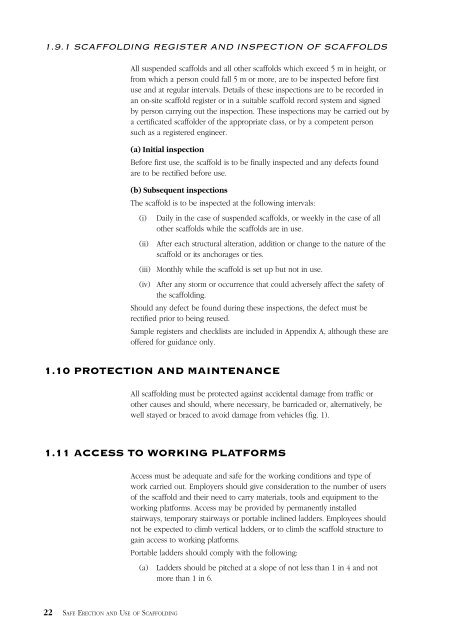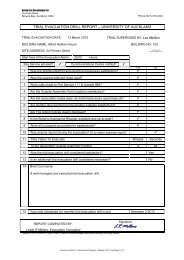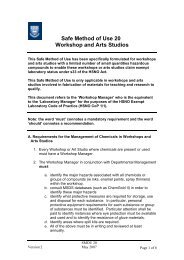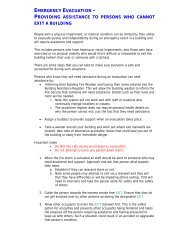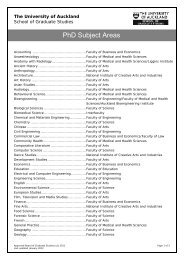Of for the safe erection and use of scaffolding
Of for the safe erection and use of scaffolding
Of for the safe erection and use of scaffolding
- No tags were found...
You also want an ePaper? Increase the reach of your titles
YUMPU automatically turns print PDFs into web optimized ePapers that Google loves.
1.9.1 SCAFFOLDING REGISTER AND INSPECTION OF SCAFFOLDSAll suspended scaffolds <strong>and</strong> all o<strong>the</strong>r scaffolds which exceed 5 m in height, orfrom which a person could fall 5 m or more, are to be inspected be<strong>for</strong>e first<strong>use</strong> <strong>and</strong> at regular intervals. Details <strong>of</strong> <strong>the</strong>se inspections are to be recorded inan on-site scaffold register or in a suitable scaffold record system <strong>and</strong> signedby person carrying out <strong>the</strong> inspection. These inspections may be carried out bya certificated scaffolder <strong>of</strong> <strong>the</strong> appropriate class, or by a competent personsuch as a registered engineer.(a) Initial inspectionBe<strong>for</strong>e first <strong>use</strong>, <strong>the</strong> scaffold is to be finally inspected <strong>and</strong> any defects foundare to be rectified be<strong>for</strong>e <strong>use</strong>.(b) Subsequent inspectionsThe scaffold is to be inspected at <strong>the</strong> following intervals:(i)(ii)(iii)Daily in <strong>the</strong> case <strong>of</strong> suspended scaffolds, or weekly in <strong>the</strong> case <strong>of</strong> allo<strong>the</strong>r scaffolds while <strong>the</strong> scaffolds are in <strong>use</strong>.After each structural alteration, addition or change to <strong>the</strong> nature <strong>of</strong> <strong>the</strong>scaffold or its anchorages or ties.Monthly while <strong>the</strong> scaffold is set up but not in <strong>use</strong>.(iv) After any storm or occurrence that could adversely affect <strong>the</strong> <strong>safe</strong>ty <strong>of</strong><strong>the</strong> <strong>scaffolding</strong>.Should any defect be found during <strong>the</strong>se inspections, <strong>the</strong> defect must berectified prior to being re<strong>use</strong>d.Sample registers <strong>and</strong> checklists are included in Appendix A, although <strong>the</strong>se are<strong>of</strong>fered <strong>for</strong> guidance only.1.10 PROTECTION AND MAINTENANCEAll <strong>scaffolding</strong> must be protected against accidental damage from traffic oro<strong>the</strong>r ca<strong>use</strong>s <strong>and</strong> should, where necessary, be barricaded or, alternatively, bewell stayed or braced to avoid damage from vehicles (fig. 1).1.11 ACCESS TO WORKING PLATFORMSAccess must be adequate <strong>and</strong> <strong>safe</strong> <strong>for</strong> <strong>the</strong> working conditions <strong>and</strong> type <strong>of</strong>work carried out. Employers should give consideration to <strong>the</strong> number <strong>of</strong> <strong>use</strong>rs<strong>of</strong> <strong>the</strong> scaffold <strong>and</strong> <strong>the</strong>ir need to carry materials, tools <strong>and</strong> equipment to <strong>the</strong>working plat<strong>for</strong>ms. Access may be provided by permanently installedstairways, temporary stairways or portable inclined ladders. Employees shouldnot be expected to climb vertical ladders, or to climb <strong>the</strong> scaffold structure togain access to working plat<strong>for</strong>ms.Portable ladders should comply with <strong>the</strong> following:(a)Ladders should be pitched at a slope <strong>of</strong> not less than 1 in 4 <strong>and</strong> notmore than 1 in 6.22 SAFE ERECTION AND USE OF SCAFFOLDING


